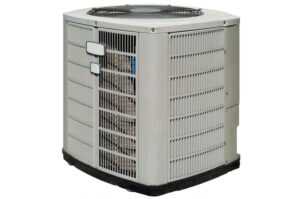
Heat pumps are similar to air conditioners. In fact, air conditioners are technically classified as a type of heat pump. A heat pump is a device that uses the circulation of refrigerant to pump heat from one location to another. In the case of an air conditioner, the system is designed to pump heat in one direction: from inside a house to the outside. A standard heat pump is designed to be able to switch the direction it can move heat so that it operates as both a cooling system and a heating system depending on the setting.
For a heat pump to work in both modes, it has several features an air conditioner doesn’t have. To help you better understand how a heat pump is able to serve its two functions, we’re going to take a look at what parts make it different from an air conditioner.
The reversing valve
This is the key component that sets apart an air conditioner from a two-mode heat pump. In an air conditioner, hot, high-pressure refrigerant exits the compressor and travels directly to the outdoor coil, where it will release heat and cool down.
In a heat pump, the refrigerant exits the compressor and goes into a reversing valve, a pipe section that can either send the refrigerant to the outdoor coil or the indoor coil depending on instructions received from the thermostat. If the refrigerant goes first to the outdoor coil, the heat pump will work in cooling mode. If it goes first to the indoor coil, it will work in heating mode, since it will first release heat indoors.
The suction line accumulator
Because refrigerant can change direction in a heat pump, there’s a heightened risk that liquid refrigerant will flow the wrong direction into the compressor, where it will mix with oil and caused the compressor to burn out. To help prevent this, a suction line accumulator draws out the excess refrigerant that may move in the wrong direction.
The defrost controls
During the winter when the heat pump is working in heat mode, it draws thermal energy from the outside. As the coil absorbs the outdoor heat, it also causes condensate moisture to form along the coil, and in sub-freezing temperatures, this moisture will turn to ice and block further heat absorption. A heat pump has a defrost control that periodically activates to melt away the ice. The heat pump briefly reverses the refrigerant flow to release heat through the outdoor coil and defrost it. (This is why you may see steam coming off your heat pump during winter. Don’t be alarmed, it’s not smoke!)
A second expansion valve
A heat pump needs to have two expansion valves to lower the refrigerant’s pressure and temperature as it circulates.
If you have any questions about heat pumps or want to know if one is right for your home, we’re the HVAC service in West Chester, PA who can take care of you. We’re family-owned and locally operated.
Michall Daimion Heating & Air Conditioning, Inc. is the Main Line’s premier service provider since 1976. Call us for heat pump service today.
